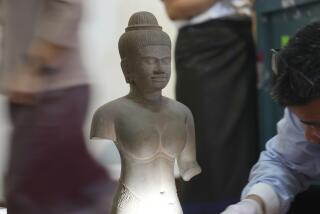Tibetan Exhibit Is More Political Artifice Than Art, Protesters Say
- Share via
Officials at the Bowers Museum of Cultural Art in Santa Ana insist that their current exhibit, “Tibet: Treasures From the Roof of the World,” is about art, not politics.
But it was hard to ignore the nearly 70 Tibetan protesters who gathered Saturday morning in front of the museum to denounce what they called the Bowers’ sanitized depiction of their country’s history.
China annexed Tibet in 1951. When troops crushed an uprising in 1959, thousands fled the mountainous country, including the Dalai Lama, the supreme spiritual leader of Tibetan Buddhists and the charismatic symbol of Tibetan resistance.
There is no mention of the Dalai Lama or the Chinese occupation in the Bowers’ exhibit.
“The museum is deliberately misinforming the public about Tibet,” shouted Tao Tenzing Dhamcho, president of Los Angeles Friends of Tibet. “We demand the truth.”
Around him, under a morning light drizzle, people clutched umbrellas and pictures of the Dalai Lama. Some wore red masks over their mouths in protest and carried signs that said “Give Tibet Voice.” Another sign said “Bowers = Beijing’s Puppet.”
Rick Weinberg, the museum’s director of public relations and marketing, said that the Bowers’ only goal was to showcase Tibet’s culture and art.
“It would be inappropriate,” he said, “for us to take a political stance.”
But politics seemed unavoidable Saturday.
The day marked the beginning of the Tibetan new year, and the Bowers had invited a group of Tibetan Buddhist monks to perform a cultural pageant.
The monks, who live in exile in India, performed dances and chants in a conference room. Behind them a picture of the Dalai Lama was prominently displayed. They also presented a slide show that the monks said depicted political prisoners of the Chinese government.
Museum visitors could not ignore the politics either. They said it added to their experience.
“It gives it more weight,” said Stan Morris of Lake Forest, who was visiting with his wife, Claudia, and his mother-in-law. “What is here is not just artifacts, but part of the history and culture that [the protesters] are fighting for.”
The exhibit of about 200 items, which will be at the Bowers through Sept. 12, includes colorful thanka paintings and ornate religious articles hundreds of years old.
The artwork came from three palaces in Tibet, and had never been seen in the West, Weinberg said.
“It was a monster coup for us,” he said. “It is the museum equivalent of winning the Super Bowl.”
The relatively small Orange County gallery has gained a reputation in recent years for rare and exquisite exhibits. Four years ago, its “Secret World of the Forbidden City: Splendors from China’s Imperial Palace” was a blockbuster success. Last year, “Symbols of Power: Masterpieces from the Nanjing Museum” marked the first time that the Chinese museum allowed its collection to travel outside the country.
Weinberg said the protesters “should be incredibly proud. The exhibit allows people to gain greater appreciation and knowledge of Tibetan art and Tibetan culture.”
It wasn’t quite pride that protester Tseten Phanucharas was feeling. “Let’s say your family suffers a home-invasion robbery,” the 56-year-old from Malibu said. “Then a museum negotiates with the robbers to display your things. You should be grateful because now you can look at your possessions?”
Phanucharas left Tibet when she was 11, just before the uprising. She said she hasn’t been able to return since.
More to Read
Sign up for Essential California
The most important California stories and recommendations in your inbox every morning.
You may occasionally receive promotional content from the Los Angeles Times.










